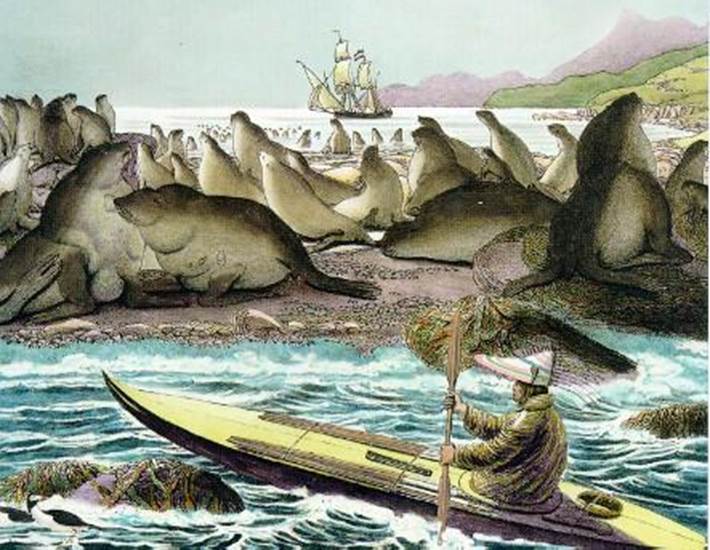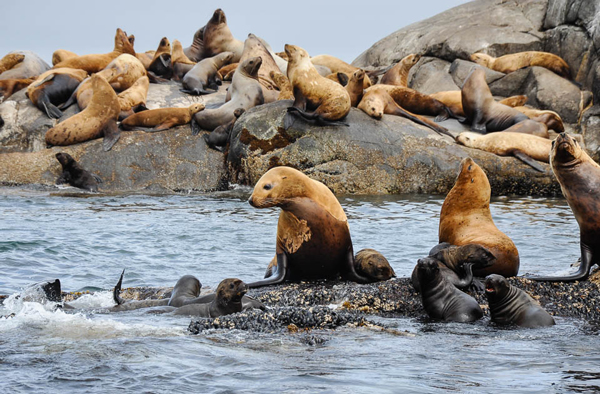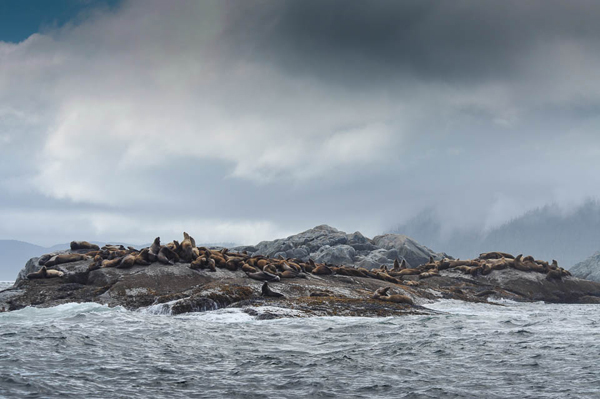
image caption: An Aleut hunter in the Bering Sea with an anchored Russian ship in the background (watercolor by Louis Choris, 1816)
In 1997, the U.S. National Marine Fisheries Service classified the Western Alaskan population of Steller sea lions as Endangered. Reacting to concerns about a population crash — some 200,000 sea lions had disappeared without a trace since 1977 — and assuming the culprit was overfishing, federal authorities abruptly halted fishing near sea lion habitats in the Gulf of Alaska, Bering Sea and Aleutian Islands.
The ban baffled the indigenous fishers of the Alaskan Peninsula and the Aleutian Islands, who have subsisted on Steller sea lions for more than 10,000 years. How could the decline be caused by overfishing when local fishers were catching more cod and pollock than they had in generations? Convinced that the decline in Steller sea lions had nothing to do with overfishing, the indigenous people of Western Alaska turned to Dr. Herbert Maschner (Idaho State University) for help.
Maschner, an anthropologist and archaeologist who grew up in Fairbanks, has been actively researching and collecting data on human history in Alaska for more than 25 years. Lending his considerable expertise in Alaskan history and pre-history to the Consortium’s multidisciplinary scientific research program, Maschner uncovered new insights and information on the relationship between humans and Steller sea lions since the last Ice Age.

Adult females with Steller sea lion pups playing in shallow waters.
In a new paper published in Fish and Fisheries, Maschner and colleagues provide a thorough historical context for the current Steller sea lion decline, offering critical insights into five of the leading scientific explanations behind its cause (fisheries competition, environmental change, predation by killer whales, anthropogenic effects, and disease).
Dynamic Landscape
“Humans, and especially biologists, have a notion that everything in the past was static and everything modern is changing because of human interactions,” Maschner says. “They don’t think of humans on the landscape. But the past was a highly dynamic landscape that included humans, and that landscape responded to many of the same problems that species face today.”
In the study, Maschner and colleagues present anthropological and archaeological evidence that Steller sea lion numbers have repeatedly declined and recovered over the past 4,500 years. Maschner says that historical observations by locals, explorers, and others since the late 1800s have consistently associated low Steller sea lion populations with high populations of Pacific cod and walleye pollock. According to these observations, Steller populations were most recently at critically low numbers during the 1870s-1930s—long before the first scientific census in 1956.

“The problem is really one of shifting baselines—except there are no baselines!” Maschner explains. “Populations throughout history are so dynamic that we don’t know whether today’s Steller sea lion decline was actually a crash, or whether they are just going back to a normal level.” He points to the population counts in the 1960s and 1970s, which biologists consider a benchmark for “pristine” numbers of Steller sea lions before the harvests and commercial fisheries of the last 40 years. Maschner notes that these surveys were taken during a period in which Steller sea lions were relatively abundant, the ocean climate was cooler, and humans had stopped harvesting sea lions in meaningful numbers.
Maschner also suggests the possibility that a good portion of the North Pacific marine ecosystem has adapted to human harvesting—and that accordingly, the behavioral ecology of Steller sea lions may have adapted to a certain level of harvesting by humans. He presents archaeological evidence showing that Steller sea lions have historically avoided human settlements when sea lion populations were low, and they ventured closer to humans when sea lion populations were abundant. He also provides evidence that larger human populations have historically not overexploited sea lion populations—in fact, the opposite was frequently true.
“Our data show that the whole idea of a pre-European environment that was rich and static and abundant was a figment of imagination,” Maschner says. “There were warm periods in the past when Steller sea lions declined, and the humans that harvested them also declined.”
Climate is Key
Indeed, the human activities that Maschner believes will contribute most to the decline or recovery of Steller sea lions are activities that enhance or diminish climate change.
“During warm periods, primary productivity goes down,” he explains. “The kind of zooplankton that support fish populations also change, and the overall productivity of the Pacific Ocean drops considerably. This reverses during cold periods, and the cycle mimics the rise and fall of sea lion populations. We can’t solve the problem of Steller sea lion populations unless we solve climate change.”

Steller sea lions hauled out above the ocean swells.
The new study provides strong archaeological and anthropological evidence to support the current ocean climate hypothesis proposed in Trites, Miller, Maschner et al. (2007)—that that the key driver of Steller sea lion population declines or recoveries are periodic “regime shifts” in ocean climate, the most recent of which occurred in 1977. Maschner and colleagues suggest that while factors like removals by people and predation by killer whales did not cause the current decline, they may have made it worse.
Maschner calls the current study a “great collaboration between biology and the social sciences” and cautions against viewing the Steller sea lion decline as a purely scientific problem unique to the 21st century.
“Government policy and management decisions are made using scientific fisheries models that say, ‘before fishing, this is what the ocean looked like,’” he says. “The problem is, there hasn’t been a ‘before fishing’ for 10,000 years.”
 PUBLICATION
PUBLICATION
|

|

 |
||||||||||||
